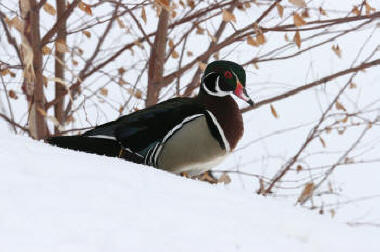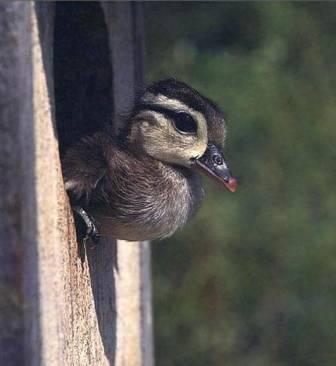REproduction
The Mate
 Many
accounts have been made that the Wood Duck is one of the "faithful" animals in
nature and that partners remain together until the other perishes. Although this
may be true to a certain extent, many modern studies say otherwise, and that are
no truly monogamous species. This has to do with two main ideas in nature. 1.
Genetic variation is a good thing in nature. 2. Animals need soap operas too.
(That last one isn't true, by the way.)
Many
accounts have been made that the Wood Duck is one of the "faithful" animals in
nature and that partners remain together until the other perishes. Although this
may be true to a certain extent, many modern studies say otherwise, and that are
no truly monogamous species. This has to do with two main ideas in nature. 1.
Genetic variation is a good thing in nature. 2. Animals need soap operas too.
(That last one isn't true, by the way.)
Some courtship does take place, however. Drakes often engage
in mild scuffles that rarely result in injury, but inevitably produce a victor.
The Clutch
The Wood Duck is oviparous, meaning that
it produces eggs that hatch after being lain by the mother. Hens commonly lay
around 12-15 eggs per clutch every spring upon returning to breeding grounds.
The Nest
Wood Ducks have been known to make their nests in a variety of
different places. The preferred habitat for nesting is in the cavities of trees,
but man-made houses have become popular as decaying trees fall, or are chopped
down by man.
Hens are commonly known to lay about one egg a day until her
clutch is complete. The hen does not remain atop her eggs for the entire period
however. Before exiting her nest, hens carefully cover their eggs with grass,
dirt, and feathers to produce a makeshift blanket capable of keeping them warm
and hidden from intruders like raccoons.
Once she has lain her last egg, the hen incubates the eggs
almost nonstop until they begin to hatch about 30 days later.

The Hatch
Once hatched, the ducklings spend about 24 hours in the nest
drying off from the amniotic fluid within the egg. The next day, at the hen’s
promptings, the ducklings emerge from their hole and drop to the surface below.
After this, the ducklings follow the hen to find safety.
Next,
meet the author.

Questions
or comments? Email me at
larson.chri@students.uwlax.edu
 Many
accounts have been made that the Wood Duck is one of the "faithful" animals in
nature and that partners remain together until the other perishes. Although this
may be true to a certain extent, many modern studies say otherwise, and that are
no truly monogamous species. This has to do with two main ideas in nature. 1.
Genetic variation is a good thing in nature. 2. Animals need soap operas too.
(That last one isn't true, by the way.)
Many
accounts have been made that the Wood Duck is one of the "faithful" animals in
nature and that partners remain together until the other perishes. Although this
may be true to a certain extent, many modern studies say otherwise, and that are
no truly monogamous species. This has to do with two main ideas in nature. 1.
Genetic variation is a good thing in nature. 2. Animals need soap operas too.
(That last one isn't true, by the way.)